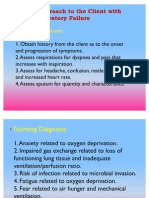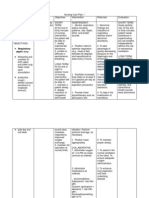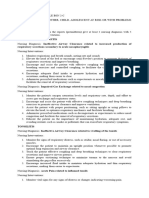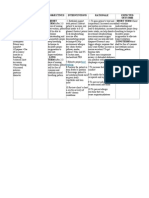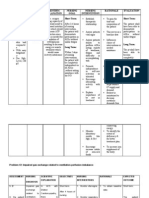NCP Kochs2
NCP Kochs2
Uploaded by
Ava VierCopyright:
Available Formats
NCP Kochs2
NCP Kochs2
Uploaded by
Ava VierOriginal Title
Copyright
Available Formats
Share this document
Did you find this document useful?
Is this content inappropriate?
Copyright:
Available Formats
NCP Kochs2
NCP Kochs2
Uploaded by
Ava VierCopyright:
Available Formats
Nursing Diagnosis: Ineffective airway clearance related to inability to remove airway secretions secondary to disease process as manifested by difficulty
in breathing, increased respiratory rate and verbalization of Marigatan nak umanges ading . Nursing Inference Kochs disease can cause a wide range of effects in the lungs, ranging from a small patch of bronchopneumonia to diffuse intense inflammation, caseous necrosis, pleural effusion, and extensive fibrosis. Respiratory effects can range from mild dyspnea to profound respiratory distress. Accumulation of secretions and compromised airway can impair oxygenation of vital organs and tissues. Nursing Goal After 1 hour of rendering series of nursing interventions the client will be able to stabilize the respiratory rate within normal range as well as the respiratory rhythm and verbalization of Hanak marigatan umangesen ading . Nursing Intervention 1. Position the client on high back rest. To open/maintain airway and for lung expansion. 2. Monitor respiratory rate and rhythm. To assess respiratory distress 3. Encourage deep breathing and coughing exercise. To allow lung expansion to compensate for the decreased oxygen level in the lungs 4. Instruct client to increase oral fluid intake. To help liquefy mucus secretions 5. Perform suctioning as needed. To remove mucus secretions obstructing the airway 6. Administer oxygen as ordered. To provide additional oxygen to the client 7. Administer mucolytic, expectorant and antibiotics as ordered. To liquefy mucus secretions, expel the secretions that obstruct the airway and kill the bacteria. Nursing Evaluation After 1 hour of rendering series of nursing interventions the client was able to stabilize the respiratory rate within normal range as well as the respiratory rhythm and verbalization of Hanak marigatan umangesen ading .
Nursing Diagnosis Activity intolerance related to imbalance oxygen demand and supply as evidenced by reports of fatigue, weakness and exertional dyspnea.
Nursing Inference Frequent cough, sputum production and exertional dyspnea can cause fatigue.
Nursing Goal After 2-3 hours of rendering series of nursing interventions the client will be able to manifest absence of fatigue, weakness and exertional dyspnea.
Nursing Intervention 1. Encourage and provide for frequent rest periods. To conserve energy. 2. Plan activities of the client accordingly. To conserve energy 3. Administer oxygen as ordered. To provide additional oxygen to the client. 4. Assist client to identify appropriate coping behaviors. To promote sense of control and improves self-esteem.
Nursing Evaluation After 2-3 hours of rendering series of nursing interventions the client was able to manifest absence of fatigue, weakness and exertional dyspnea.
You might also like
- CVA NCP Ineffective Airway ClearanceDocument2 pagesCVA NCP Ineffective Airway ClearanceJoanne Kaye Taylor100% (1)
- Nursing Management For Acute Respiratory FailureDocument7 pagesNursing Management For Acute Respiratory FailureEvolynNo ratings yet
- Revised NCP (Baiae)Document9 pagesRevised NCP (Baiae)Jennifer BactatNo ratings yet
- NCP For PneumoniaDocument3 pagesNCP For PneumoniaKahMallari100% (12)
- NCP - Sta. 6Document2 pagesNCP - Sta. 6vmasalarda2019No ratings yet
- Cues Nursing Diagnosis Planning Nursing Interventions Rationale Evaluation GoalDocument4 pagesCues Nursing Diagnosis Planning Nursing Interventions Rationale Evaluation GoalKei Cruz100% (1)
- Ncp'sDocument8 pagesNcp'sDuchess Kleine RafananNo ratings yet
- Nursing Care PlanDocument4 pagesNursing Care PlanKoleen KirstenNo ratings yet
- NCP BaiaeDocument7 pagesNCP BaiaeJonathan Delos ReyesNo ratings yet
- Comprehensive ExaminationDocument8 pagesComprehensive ExaminationAnonymous dquW2YmO7No ratings yet
- Wk2 NCP Edited2012Document6 pagesWk2 NCP Edited2012Jessely Caling SalasNo ratings yet
- NCP Ineffective Breathing PatternDocument2 pagesNCP Ineffective Breathing PatternChristianmel JavierNo ratings yet
- Maternal Ni SheenaDocument13 pagesMaternal Ni SheenaSheena Marie M. TarleNo ratings yet
- AssesmentDocument9 pagesAssesmentmizrypNo ratings yet
- ARDSDocument18 pagesARDSChurrizo IslamiNo ratings yet
- Nursing Care Plan Ineffective Airway Clearance: Assessment Diagnosis Outcome IdentificationDocument9 pagesNursing Care Plan Ineffective Airway Clearance: Assessment Diagnosis Outcome IdentificationAngelokeizer GavinoNo ratings yet
- Ch50 NCP IneffAirClear 1395-1396Document2 pagesCh50 NCP IneffAirClear 1395-1396Caress Mae Gubaton CabudoyNo ratings yet
- NCPDocument4 pagesNCPAbegail Abaygar100% (1)
- NCP Ineffective Airway ClearanceDocument1 pageNCP Ineffective Airway ClearanceImation DataNo ratings yet
- Lab Workbook - Assignment 8 RespiratoryDocument14 pagesLab Workbook - Assignment 8 RespiratoryromanparadizeNo ratings yet
- Pleural Effusion NCPsDocument7 pagesPleural Effusion NCPsJaja Nagallo100% (2)
- PNEUMONIADocument24 pagesPNEUMONIAwheeyycoldandhot55No ratings yet
- Nursing Diagnosis (1) (1) .Finalgid NiyaDocument30 pagesNursing Diagnosis (1) (1) .Finalgid NiyaReadcast EFNo ratings yet
- Nursing Care Plan 2Document1 pageNursing Care Plan 2JOYCE ANNE SUERTE DAGDAGANNo ratings yet
- Bronchial Asthma NCPDocument6 pagesBronchial Asthma NCPRacelle DelesNo ratings yet
- Bronchitis Nursing Care PlanDocument8 pagesBronchitis Nursing Care PlanBryan NguyenNo ratings yet
- Postural DrainageDocument6 pagesPostural DrainageKit Alizon Barredo0% (1)
- NCP SDocument8 pagesNCP SMarvie CadenaNo ratings yet
- Nursing Care Plan Problem: Difficulty of BreathingDocument5 pagesNursing Care Plan Problem: Difficulty of BreathingIvan Louise Fajardo ManiquizNo ratings yet
- Myrna CruzDocument3 pagesMyrna CruzChris Opal NamocatcatNo ratings yet
- Nursing Care Plans of Bronchial AsthmaDocument8 pagesNursing Care Plans of Bronchial AsthmaKannanNo ratings yet
- NCP & Prio!!!Document45 pagesNCP & Prio!!!Sj 斗力上100% (1)
- Ncp's FOR PLEURAL EFFUSIONDocument4 pagesNcp's FOR PLEURAL EFFUSIONHania Polangi100% (1)
- Most Common Nursing Care Plans (1)Document96 pagesMost Common Nursing Care Plans (1)rn.nursetomlinsonNo ratings yet
- Intervention Rationale: Provides A Basis For Evaluating Adequacy of VentilationDocument1 pageIntervention Rationale: Provides A Basis For Evaluating Adequacy of VentilationEricka VillanuevaNo ratings yet
- Effective Airway Care PlanDocument5 pagesEffective Airway Care PlanheidiNo ratings yet
- School of Nursing and Allied Medical Sciences: Holy Angel UniversityDocument19 pagesSchool of Nursing and Allied Medical Sciences: Holy Angel UniversityMonica BorjaNo ratings yet
- 4 NCP's FinalDocument9 pages4 NCP's FinalZenel Yap100% (1)
- Ineffective Airway Definition and ConceptDocument10 pagesIneffective Airway Definition and ConceptakudavizioNo ratings yet
- NCPDocument9 pagesNCPEjie Boy Isaga67% (3)
- Nursing Diagnosis Nursing Intervention Rationale Breathing PatternDocument7 pagesNursing Diagnosis Nursing Intervention Rationale Breathing PatternJinaan MahmudNo ratings yet
- COPD Care PLAN PDFDocument2 pagesCOPD Care PLAN PDFVanessaMUeller100% (1)
- Ineffective Breathing PatternDocument2 pagesIneffective Breathing PatternjuanmarcostaglishNo ratings yet
- Oxygen Administration ScriptDocument2 pagesOxygen Administration ScriptTyn TynNo ratings yet
- Competencymr McdougalcopdDocument17 pagesCompetencymr Mcdougalcopdmac_rymrt7569No ratings yet
- Cap MRDocument3 pagesCap MRRhio Grulla RamboyongNo ratings yet
- Woman With PneumoniaDocument9 pagesWoman With PneumoniaNohaira SADANGNo ratings yet
- Activity Intolerance NCPDocument6 pagesActivity Intolerance NCPDoo NahNo ratings yet
- NCP RespiDocument3 pagesNCP Respinov2024pnletop1No ratings yet
- Nursing Diagnosis For AsthmaDocument6 pagesNursing Diagnosis For AsthmaTINAIDA33% (3)
- Ineffective Airway ClearanceDocument6 pagesIneffective Airway Clearanceapi-253288732No ratings yet
- BronchiectasisDocument40 pagesBronchiectasisyana jaeNo ratings yet
- Nursing care process in patients with chronic obstructive pulmonary diseaseFrom EverandNursing care process in patients with chronic obstructive pulmonary diseaseNo ratings yet
- A Simple Guide to Oxygen Therapy, Diagnosis, Treatment and Related ConditionsFrom EverandA Simple Guide to Oxygen Therapy, Diagnosis, Treatment and Related ConditionsNo ratings yet
- Snoring, A Simple Guide To The Condition, Treatment And Related ConditionsFrom EverandSnoring, A Simple Guide To The Condition, Treatment And Related ConditionsNo ratings yet
- NCLEX-RN Physiological Integrity Exam Prep :300 Practice Questions with Detailed Answers and Explanation to Master Your Exam: NCLEX-RN EXAM PREP:PRACTICE QUESTIONS AND ANSWERS, #4From EverandNCLEX-RN Physiological Integrity Exam Prep :300 Practice Questions with Detailed Answers and Explanation to Master Your Exam: NCLEX-RN EXAM PREP:PRACTICE QUESTIONS AND ANSWERS, #4No ratings yet
- Aspiration Pneumonia, A Simple Guide To The Condition, Diagnosis, Treatment And Related ConditionsFrom EverandAspiration Pneumonia, A Simple Guide To The Condition, Diagnosis, Treatment And Related ConditionsRating: 5 out of 5 stars5/5 (1)
- Sighing, A Simple Guide To The Condition, Diagnosis, Treatment And Related ConditionsFrom EverandSighing, A Simple Guide To The Condition, Diagnosis, Treatment And Related ConditionsNo ratings yet

